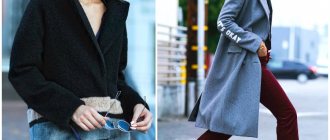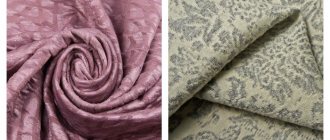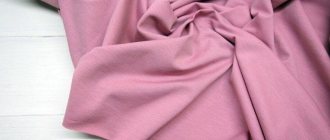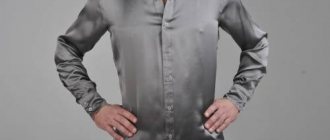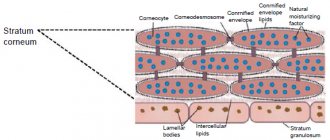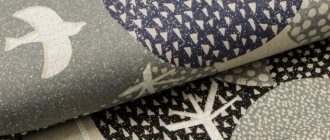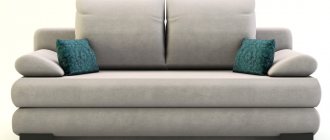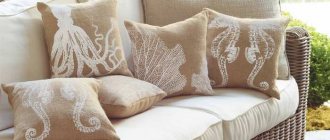Knitwear is
An elastic fabric that is not woven, but knitted. Therefore, the phrase “knitted fabric” is not entirely correct; it is better to say “knitted fabric”. During the production of knitwear, the yarn or threads bent during the knitting process have a complex spatial arrangement. The word “knitwear” itself is borrowed from the French language: tricotage from tricoter - to knit. Indeed, if you look closely at the texture of the fabric, you will notice a knitted structure created using the loop method on a special knitting machine.
Fun fact: “knitwear” and “jersey” are the same thing. It’s just that in the countries of Western Europe and the American continent the name “jersey” is accepted, which when translated into Russian means “knitted fabric of a smooth weave (knitted).” But both words are used with equal frequency. Moreover, they are often perceived not as synonyms and even begin to be endowed with different properties.
It is difficult to say exactly when and under what conditions knitwear or the first knitted product appeared. It can certainly be said that people created knitted items even before our era. It’s interesting that at first everything was done by hand—literally knitted with fingers. Then, with the invention of knitting needles and crochet, knitting improved and became a separate profession. At the same time, finely handmade knitted items, for example, high-quality stockings made from silk yarn, could be very expensive - only wealthy people could afford them. Of course, this did not apply to simple knitted items made from coarse yarn.
The first loom for knitting knitwear was invented in 1589. The inventor of this mechanism was William Lee, an assistant parish priest from England. The inspiration for the loom came from Lee's wife, who knitted for a living. He wanted to help her automate this process, thereby making her backbreaking work easier. An experienced knitter performed about 100 stitches per minute, and the new machine could increase the speed to 600. There is a legend that Queen Elizabeth I herself visited the inventor to study his creation. Unfortunately, she did not like the machine; the products created from coarse wool seemed too dense and not as high quality as they could have been as a result of hand knitting. Even after finalizing the technical nuances, William Lee did not receive a patent from the Queen. Some justify this act by Elizabeth’s reluctance to deprive knitters of their income. This attitude forced the priest to move from England to France, where he was able to successfully develop his own business. His machines spread quickly throughout Europe.
Types of knitwear: main varieties
There are many varieties of knitwear. At the same time, the following types of knitted fabrics are most widespread:
- Kulirka (kulirka smooth surface). Thin, light, easy-to-manufacture fabric, used primarily for the production of children's clothing and underwear.
- Ribana. Almost 100% cotton textiles, but also containing synthetic lycra.
- Interlock. Smooth and dense material on the inside and outside. Used for sewing sportswear, dressing gowns, nightwear.
- Footer. The densest type, which also has a noticeable backcomb. Suitable for the production of overalls, household home clothing, various items for children and many other products.
- Viscose. A synthetic material produced from wood fibers. Viscose knitwear has a fairly wide range of applications (from clothing to making boots).
It is also worth distinguishing between the French type of knitted fabric. Many people do not know what kind of fabric French knitwear is, a photo of which can be viewed on our website. At the same time, the main difference between the French type of textile is that in the process of its production a special technology of weaving threads is used, which allows this knitwear to be endowed with additional properties of resistance to deformation, creasing and stretching.
The composition of the French knitwear fabric includes exclusively natural ingredients, so it is environmentally friendly, pleasant to the touch, and does not cause allergies.
On the left in the photo is a French type of knitted fabric:
When did knitwear come into fashion?
It is impossible to talk about the role of knitwear in the world of haute couture without mentioning two talented women - Coco Chanel and Elsa Schiaparelli. Already in the late 1920s, knitted sweaters were shining on the catwalk in Schiaparelli's collection. For the beginning of the 20th century, this was an unusual and bold discovery. There is a version that Elsa first saw a similar sweater on her friend, and he, in turn, said that it was knitted by an emigrant from Armenia. Coco Chanel, in turn, gave the history of fashion machine-made knitwear - jersey. Before her, this fabric was used mainly for sewing men's underwear. The Frenchwoman dared to create elegant clothes for ladies of the privileged class from jersey. An unimaginably daring decision!
The main manufacturers of knitwear in TISSOURA: Marioboselli Jersey (Italy), Guigou (France), Hausammann (Switzerland), Binda (Italy), Carnet (Italy).
Jersey composition
A wide variety of materials are used as raw materials for the production of knitted fabrics:
- natural (cotton, wool, linen, silk);
- artificial (acetate, viscose and its varieties)
- synthetic (lycra, polyester, elastane)
High-quality knitwear always has a natural base. And in order to enhance the beneficial characteristics of future knitted products, a certain percentage of synthetic fibers is added to the composition. For example, cotton in its pure form can wrinkle a lot, but if you add 5% lycra to the composition, the material will become more “obedient” - it will stretch easily, and after stretching it will easily take its previous shape. In addition, natural fibers are not strong and durable, but in combination with artificial threads they will provide an excellent wear-resistant material.
Therefore, it is best to choose knitwear with a combined composition.
What's in knitwear?
Knitted fabric can be made from yarn of a wide variety of origins. The composition varies depending on the purpose and functionality of the canvas. Knitwear made from natural fibers is especially valued. The raw materials used are silk, linen, cotton, wool and various synthetic materials in the form of additives. They can vary in type of twist and length. Most often, combined options are used, which combine natural and synthetic materials.
Elastane is often added to knitted fabrics to increase elasticity and the ability to retain shape. Combined knitwear usually combines the best properties of natural and synthetic materials. For example, pure cotton wears out and wrinkles a lot, does not fit well, and synthetic fabrics are electrified and can cause allergies. When producing mixed, that is, combined fabrics, manufacturers achieve a harmonious combination of the best characteristics of each type of raw material.
What's in it
The composition of knitwear can contain fibers of the same type or a mixture of different threads. The source of raw materials is flax, viscose, silk, cotton and wool, as well as synthetic fibers. To obtain yarn, various twisting technologies are used, which affects the properties of the finished fabric. A common option is mixed fabrics made from natural and synthetic raw materials.
Description of fibers for making knitwear:
- Viscose is an artificial thread made from wood cellulose.
- Cotton is of natural, plant origin. Softness and hygroscopicity.
- Lycra is a cellulose fiber that has been treated with vinegar anhydrite.
- Silk is a thread obtained from the protein cocoons of the silkworm. It has lightness, strength and glossy shine.
- Elastane is an elastic fiber of synthetic origin.
- Twisted threads from the wool of goats, sheep and camels.
Natural knitted fabric consists of cotton or wool. For linen it mainly contains cotton or viscose threads. Insulated clothing is made from loose-textured wool yarn.
Hosiery products are made from cotton, polyamide, nylon, viscose and wool. To obtain products with a smooth surface, synthetic threads are added. Things made of polyester wear and wash well, but are less comfortable and prone to pilling.
Types of knitwear
Knitted fabrics differ according to several criteria: density, composition, additional materials, design, texture and structure. We will tell you more about the types of knitwear below.
Depending on the method of combining weaves of different classes in knitwear, knitwear is distinguished into simple, derivative-combined, patterned and complex combined weaves. In addition to class, weave can be characterized by rapport. Knitwear is also characterized by stretchability, strength, unraveling (both in the direction of knitting and against it), edge curl, and surface density.
Advantages and disadvantages
The popularity of knitwear is explained by its variety of shapes. Using different threads as a base, you can get a completely different product both in appearance and in its properties. Let's talk about its advantages and disadvantages.
Positive traits:
- Practicality;
- Easily take the shape of the body;
- Soft and pleasant to the touch;
- Strength and durability;
- Easy to care for;
- Variety of colors;
- Knitted products do not restrict movement;
- Do not accumulate static electricity;
- Create a comfortable temperature at any time of the year;
- Wide range of applications;
- Hygiene;
- Affordable price;
- Hygroscopicity.
Flaws:
- Fairly simple appearance;
- They can stretch if cheap raw materials were used;
- Products can highlight all the imperfections of the figure.
Manufacturing methods
The main elementary link in the structure of a knitted fabric is a loop, consisting of a core and a connecting broach. Loops located horizontally form loop rows, and loops located vertically form loop columns. The terms “lobe” and “weft” are not for knitted fabric.
- Weaving options
Cross-knitted knitwear is formed from one thread using one system of threads; Knitted loops are straight and can open vertically and horizontally. This knitwear is elastic in the transverse direction and retains its shape well.
Warp knitwear is formed from all the warp threads, each loop is knitted with its own thread. Warp knitted fabric has slanted loops, does not unravel horizontally, and has very little unraveling vertically.
- Knitwear finishing options
Finishing of knitwear mainly consists of the same operations as finishing of fabrics - bleaching, stabilization (for knitwear made from synthetic threads), dyeing or printing, napping (for some types of knitwear) and final finishing.
Classification of knitwear
So, knitwear can be divided according to the following parameters: firstly, by composition, secondly, by structure, thirdly, by type of weave, fourthly, by finishing method, and finally, fifthly, by type of raw material for the manufacture of. Next we will consider them in more detail.
Types of knitwear composition can be from:
- cotton fibers;
- wool fibers;
- synthetic fibers;
- combined fibers.
The best of the above options is considered to be a combined option, since all fibers have their own advantages and disadvantages, and when combined, they are compensated and significantly affect both the wear life and the appearance of the final product.
The combined option, in turn, can also be divided into: mixed, heterogeneous and vigone.
Mixed when a small amount of other fibers is added to a base of one type of fiber.
Heterogeneous, when it is impossible to distinguish which fibers predominate over which.
Vigonyevy, when wool fibers are added to the cotton base.
The structure of the knitwear can be:
- warp knitted, when all the warp threads are knitted separately, and the cross weave is obtained by shifting the thread several needles to the right. This knitwear does not unravel either lengthwise or crosswise. This structure includes (chain, tights, satin). The chain is mainly used to create fringe, which, for example, is relevant this season. Satin is used more widely, from underwear to curtains.
- cross-knitted, when the thread consists of one fiber, according to one system. The loops are straight and, accordingly, the fabric unravels in all directions. These are kulir (smooth stitch), ribana (eraser), double inside out (interlock). The satin stitch or cooler has a main and a reverse side. The front side is smooth, made with sticks, and the back side is rough and seems to be made with arcs. As a rule, cotton is used as a basis, sometimes mixed with lycra and used for sewing summer clothes, underwear, and bathrobes. Eraser or ribana is an elastic fabric with a small stripe. It contains lycra, which prevents wrinkles. Used for sewing turtlenecks and cuffs. The double-sided pattern resembles the reverse side of a cooler, and is used for headscarves and scarves. Interlock has an elastic pattern and is made from cotton with the addition of elastane. Suitable for sewing T-shirts, pajamas and underwear. It can be single or double. A single has a front and a back side, and a double has two front sides.
Weaves in knitwear can be:
- main ones (smooth surface and eraser);
- derivatives;
- patterned (combined);
- complex (openwork, jacquard).
Types of knitwear according to the finishing method can be as follows:
- harsh, not subject to processing;
- bleached, it is bleached to make it homogeneous and remove various impurities;
- plain-colored - plain-colored;
- variegated, having a variegated color.
Knitwear can also be smooth or fleecy. To give the fabric a “fluffy” feel, the fabric is combed in a certain way.
Types of knitted fabrics
Footer
The homeland of footer is India, and it was there that they learned how to make this cotton knitwear. Soft fabric with fleecy fleecy on one side. Durable and warm knitted fabric.
Kulirka, or kulirka surface.
A cross-knitted knitted fabric, on the front side there is weaving in the form of longitudinal braids, and on the back side the pattern resembles very fine brickwork. It stretches very well in width and practically does not stretch in length. Used for the manufacture of linen products and summer clothes. The terms “pene”, “carde”, “ring”, “open end” are related to cotton stockinette and are associated with the length of the fibers from which the threads are twisted. “Penya” are the longest, “oppened” are the shortest.
Jersey
Same as knitwear.
Pique
It is distinguished by a complex weave, thanks to which a fine pattern is formed on the surface. Tissura's assortment consists mainly of pique cotton from the Italian manufacturer Carnet. Designs – colorful prints in the form of flowers. Initially, this lightweight knitwear was used to sew polo shirts.
Selanik
Soft, rather dense fabric with a delicate texture. On the wrong side there is a fluffy bouffant.
Lacoste
It is distinguished by a loose, homogeneous structure reminiscent of a honeycomb.
Interlock
Soft, comfortable double jersey. When making the fabric, two rows of knitting needles are used. Interlock knitwear is popular for the production of children's underwear, underwear, and homewear because it is very delicate and soft.
Dior
Knitwear made of synthetic fibers, characterized by a recognizable textured pattern in the form of diamonds on the surface of the fabric.
Biflex
The name literally translates as “stretching in two directions.” Indeed, due to the high lycra content, the knitted fabric stretches well in both the longitudinal and transverse directions.
Kashkorse
Knitted fabric knitted with English elastic. It is cash corse that is most often used to make cuffs, necklines, and belts.
Gipel
Typically knitwear is a loop fabric, but with gipel this is not the case. This fabric has additional weft threads that do not form loops, and the design is on the surface.
Capitonius
Multilayer fabric with insulation as an inner layer. On the outside there is a relief, but not very noticeable geometric pattern on the surface.
Otto (Ottoman)
Comfortable and practical fabric that does not stretch much, so it holds its shape well. Belongs to the category of costume materials.
Eraser
It is distinguished by a clear, easily recognizable vertical scar.
French knitwear
Initially, the name corresponded to the country of origin of this material, but gradually knitwear that was not produced in France began to be called this. Soft, elastic and comfortable fabric with a loose woven structure.
Oil or “cold” viscose fabric
Elastic knitwear, so named due to its pleasant sliding, “buttery” texture. Matter came to Europe straight from the East. The United Arab Emirates is considered the birthplace of the fabric. It is curious that in English the material is called slinky, that is, “tight-fitting”.
Ribana
Cross-knitted knitted fabric. As a result of alternating purl and knit stitches, a material is obtained that resembles a fine elastic band in texture.
Variety of knitted fabrics
Footer
It is a brushed fabric made from natural cotton. Used for children's clothing, even for the little ones. Warm and comfortable footer fabric is suitable for tracksuits, underwear, pajamas and dressing gowns. The disadvantage is that it shrinks after the first wash.
Kulirka
Kulir or kulir stitch is a light and thin knitted fabric. However, it wears well and is durable. It has a facial pattern in the form of braids. Does the jersey knit stretch or not? Yes, but only in width. It consists of cotton with the inclusion of lycra fibers. All types of summer clothing for children and adults are made from this fabric: suits, blouses, dresses, pajamas and underwear. The canvas allows air to pass through and absorbs moisture, which is especially important on hot days.
Jersey
It is a type of single weave. It stretches well and hardly wrinkles. Jersey knitwear can be either mixed, containing viscose, cotton or wool, or synthetic.
Pique
Made from silk, cotton or viscose threads. The knitting of the knitted fabric resembles a honeycomb. Cotton pique fabric is used for sewing polo T-shirts, and silk fabric is used for women's dresses.
Selanik
Thick jersey made from a mixture of synthetics and cotton. It has an eraser on the front side and a comb on the back. Used for newborns as sewing children's clothing.
Lacoste
Its weaving of threads forms a mesh structure. The fabric is ventilated and suitable for summer clothing.
Interlock
Double-sided fabric with braids on both sides. It is obtained by weaving into a 1x1 elastic band. Thick interlock knit with low stretch. Designed for sportswear, T-shirts and sleepwear.
Dior
Fabric with a plain cross or herringbone pattern.
Biflex
This type of knitwear contains nylon threads and the addition of lycra. It is durable, colorful and stretches beautifully in any direction. The supplex material is intended for dance and gymnastics costumes, swimsuits and circus clothing.
Kashkorse
Large rib knitwear. The fabric composition of the cashcorse linen includes cotton, synthetics, lycra and spandex for elasticity. Suitable for processing the edges of necklines and sleeves, as well as for sewing garments.
Gipel
The original weaving forms a pattern on the canvas. Quite light and elastic material consists of cotton and lycra fibers.
Capitonius
Thick, warm and voluminous knitwear with visible square or diamond stitching. It is also called quilted. Capitonium fabric is used for sewing cardigans, sweaters, thick winter skirts and suits.
Otto
Raised fabric with a rib like corduroy. Available in plain colors or with a print. Otto knitwear is elastic, resistant to wrinkles and wear. Consists of cotton, polyester and viscose.
Eraser
Elastic and elastic knitwear with rib 1x1, 1x2 or 2x2. Contains added lycra fiber. It is used to sew cuffs and necks for outerwear, as well as garments for adults and children.
French
It turns out to be a viscous double thread, which makes the knitwear dense. Keeps its shape and does not wrinkle when worn. French knitwear is intended for sewing dresses, skirts, sweaters, and trousers.
Oil or “cold” viscose fabric
This knitwear is very soft, delicate and elastic. It flows gracefully in the product, takes any shape and forms beautiful assemblies. The thin material oil consists of fibers of viscose, lycra and polyester.
Angora
Soft and fleecy fabric made from wool, elastane and acrylic. Recently, the composition has been based on synthetics, but the fabric has remained just as attractive.
Ribana
Fine striped fabric is made from cotton. Sometimes lycra or polyester is added to the composition. Ribbon fabric is used for outer knitwear. It is elastic, does not lose shape and lasts a long time.
Where is knitwear used?
Linen . Cotton knitwear is especially valued for creating underwear because it does not wrinkle, does not wear out quickly, and does not restrict movement! It is important that, thanks to natural fibers, this material is breathable and hygroscopic.
Shirts . The fabrics are slightly deformed and are produced mainly using charme-chain, cloth-tricot and other weaves. The plasticity and stretchability of the material makes products made from it as comfortable and easy to wear as possible.
Dresses, skirts. They are easy to wash, do not shrink much, and have low creasing.
What type of fabric is this?
Knitwear is a large group of fabrics that has different types, weaves and processing methods. The variety of raw materials used will depend on the properties of the material.
Jersey colors
From French, the word “knitwear” is translated as “knitted products”. That’s right, to create this type of fabric they use knitting technology, and not weaving with other fibers. Horizontal loops form loop rows, and vertical loops form columns.
Fabric is made in factories using knitting machines using raw materials: yarn, threads, composite threads and yarn.
Advantages and disadvantages of knitted fabric
The obvious advantages include:
- The loops take different shapes, so the fabric stretches perfectly in different directions.
- Has good breathability and regulates temperature.
- The products do not need ironing, because they do not wrinkle! It’s very convenient in the realities of a dynamic world, isn’t it?
- Knitwear does not restrict movement and fits nicely to the body.
- Not electrified.
Disadvantages noted by experts:
- Such a cozy and seemingly simple knitwear still has some drawbacks. Firstly, it stretches easily, so narrow products lose their shape quite quickly. Secondly, not everyone likes to wear tight clothes, so knitwear is not suitable for everyone.
- In addition, knitwear pills, so we recommend that you carefully monitor how your favorite clothes behave during wear.
- May stretch over time under improper storage conditions. Do not hang knitwear vertically. Store them folded.
Not a PAN thing
I'm going to one of the capital's department stores.
The knitwear department is replete with a variety of models and colors. Prices for products vary so much that they defy any logic. Comparing two jumpers. One costs 139 rubles, the second - 223. Both are not cheap. And if the price of the first can be explained by its excellent composition - 80% wool, then the cost of the second remains a mystery - PAN 70% is on the label. But the dresses are very similar in style. One contains only 8% wool and 92% synthetic fibers. The other has 30% wool and 70% PAN. Obviously, the first option is inferior to the second, but its price is almost twice as high - 129 rubles versus 69 for the second. That is, the formula “more expensive means better quality” clearly does not work here. Or maybe you shouldn’t pay attention to the composition at all? After all, consumers usually don’t focus on it - they choose new clothes based on price, color, model... Leading marketer of the Pinsk PTO “Polesie” Ekaterina Kalenyuk
assures that it is still better not to ignore the composition:
— The differences between natural and synthetic knitwear are significant. Products made from natural threads, such as cotton and wool, are hygroscopic, air and vapor permeable. Synthetic knitwear does not allow air to pass through, practically does not absorb moisture, and, in addition, is highly electrified. True, clothes made entirely from natural materials may lose their shape and shrink. The best choice is knitwear with the addition of artificial threads. They make the item stronger, and during wear it does not stretch as much. A combination of 20-30% artificial fiber (acrylic and others) and 80-70% natural fiber (cotton, wool) is considered ideal.
Rules for caring for knitwear
- Dry cleaning recommended. Cotton and viscose jersey can be washed if necessary. Hand washing is most optimal. Machine - only in delicate mode. Use a laundry bag. It is better to refuse the spin function.
- No hot water. This is a direct path to shrinkage or loss of shape of the product. The optimal temperature for washing and rinsing knitwear is 30-40 degrees.
- Don't rub. Otherwise, hated pellets will appear.
- Use only gentle detergents that do not contain alkalis, aggressive biological additives, bleaches, etc.
- Squeeze, not squeeze. Knitwear cannot be twisted. Just squeeze gently. You can also wrap the item in a towel.
- Dry horizontally, carefully straightening it out. Do not dry in direct sunlight. When heated, the cotton fibers are destroyed and the color fades.
- We recommend keeping knitwear items on a shelf, neatly folded.
Knitwear today is one of the most popular fabrics in the world. Knitwear is used to create fashionable jackets, skirts, trousers, coats and jackets.
How to care for knitwear
Do not hang wet knitwear on hangers - the product will stretch; after drying, this storage method is acceptable.
To maintain fabric in good condition for a long time, you need to follow basic textile care rules. You should follow simple rules:
- rinse the fabric several times, changing the water;
- the material does not like to be twisted and squeezed hard;
- It is not recommended to iron after washing;
- When washing in a machine, you need to select the “hand wash” mode or wash by hand;
- When washing, things should be squeezed, not rubbed;
- the water temperature should not exceed 40 degrees;
- It is forbidden to dry knitwear in a centrifuge; dry it horizontally, simply straightening the item;
- Do not use bleach during washing;
- Do not hang wet knitwear on hangers - the product will stretch;
- For storage, it is advisable to use special bags in which anti-moth products should be added;
- the powder must be dissolved in advance so that its small fractions do not leave marks on the material;
- When rinsing, be sure to use conditioner;
- You can use steam to smooth the product;
- To eliminate pellets, you need to use a razor or a special machine to remove them.
Knitwear is a very practical material. There are different types of fabric, differing in composition, weave, finishing and processing. Knitted clothing is very popular and affordable. Caring for things is easy.
Wool knitwear
Wool knitwear is loved for its ability to give clothes a stylish and modern look, while maintaining warmth and comfort. Now, in order to add a fashionable cardigan or pullover to your wardrobe, you don’t need to spend long evenings knitting woolen patterns on knitting needles. Modern knitted fabrics are fabrics that are already decorated with intricate weaves of threads. All that remains is to choose a silhouette, buy knitted jersey at TISSUR and create a new fashionable item from this, as is done from ordinary fabrics.
Characteristics
Knitted textiles can be produced from cotton, wool, synthetic and combined fibers. The most popular fabric is cotton jersey, which has all the advantages of a natural base: safe to use, hypoallergenic, and easy to care for. At the same time, experts recommend choosing combined options, because the use of additional synthetic fibers allows you to give the product better performance and performance characteristics.
Additional weaves:
- Matting material - what is it;
- What is a veil;
Knitted cotton and other types of textiles made from knitted fabric are usually characterized by strength, stretchability, unravelability, loop orientation, surface density, and edge curl.
According to the class of weaves, it is customary to distinguish between main, derivative, patterned and combined options, and according to the number of loop layers - single-layer and multi-layer products.
Jersey fabric
Luxurious jersey fabrics are perfect for elegant dresses. By the way, the name of these knitted fabrics comes from the name of the island of Jersey, part of the Channel Islands archipelago. Initially, this fabric was associated only with underwear. But the great fashion rebel Coco Chanel “made jersey what we know it as today.”
The unique properties of knitted jersey fabric make it one of the most popular and beloved among our customers. Here are the main ones:
- Jersey practically does not wrinkle
- very soft and light. Even thick wool jersey fabrics look very “airy”
- the ability to create soft, beautiful folds when draping
- knitted jersey fabrics practically do not stretch in length, remaining very flexible in width
Types of knitted fabrics
Knitwear is made from threads by forming loops and interweaving them. Loops are mainly of two types: knit and purl. The facial loops form longitudinal rows, reminiscent of pigtails. Purl loops are transverse rows reminiscent of brickwork. According to the knitting method, single and double knitwear are distinguished.
To produce single knitwear, one row of knitting needles is used. This fabric has flat vertical “braids” on one side and dense “brickwork” on the other. It stretches in width and almost does not stretch in length (couture, openwork fabric). When producing double knitwear, two rows of knitting needles are used. The fabric turns out twice as thick and has vertical “braids” on both the front and back sides. Double jersey has less stretch. The term “double knit” most often refers to dense knitted fabrics – interlock, pique. Interlock is a knitted fabric without brushing, based on complex fibers with an “elastic” structure, made of 100% cotton. The name was given because of the peculiar interweaving of the fibers. This fabric is very soft, delicate and pleasant to the body. Robes, pajamas, nightgowns, T-shirts, and underwear are made from interlock. This knitwear has good thermal insulation, and in addition, clothes made from this fabric practically do not stretch or unravel, which extends the life of things. The material is hypoallergenic and suitable for sensitive skin. Fabric composition: cotton and polyester. Fabric density – 240-330 g/sq.m. Kulir (kulir stitch) is a thin knitted fabric without fleece with a cross-knitted weave, in which a horizontal loop row is formed by successive bending of one thread. It is considered the thinnest and airiest cotton knitted fabric. Kulir stitch (kulir) is used for sewing linen, dressing gowns, and summer clothes. Lycra is often added to cotton. This does not change the quality of the fabric, but its elasticity increases by an order of magnitude. This material practically does not wrinkle, despite its thinness, it has sufficient strength. Fabric composition: 100% cotton, cotton with the addition of lycra and polyester. Fabric density – 145-180 g/sq.m. Ribana is an elastic cotton knitted fabric of medium thickness with fine stripes (1x1 elastic band) with the addition of lycra (lycra and polyester). Ribana weaving looks similar to fine striped knitting, but has its own characteristics. The peculiarity of ribana is its elasticity, due to the weaving of lycra into the fabric, thanks to which the fabric perfectly holds the desired shape. It is used when sewing turtlenecks, in particular necklines and cuffs, as well as outerwear. In addition, it makes excellent house dresses, shirts, nightgowns, pajamas and much more. The color range of ribbed textiles is rich in a bright palette and interesting colorful solutions. Clothing with facings made from this elastic fabric looks very original. Ribana is durable to use, it does not stretch, practically does not shrink, it is durable, and products made from it do not require special care. Fabric composition: cotton with lycra, cotton with lycra and polyester. Fabric density – 170-350 g/sq.m. Cashkorse is an elastic cotton knitted fabric with a knitted texture of English elastic 2x2, 3x3. It has high stretchability and holds its shape well. Used for sewing turtlenecks, blouses, jumpers. Fabric composition: cotton with lycra, cotton with lycra and polyester. Footer is a warm type of knitwear without fleece and with fleece. The front side of the fabric resembles a knitted stitch, the back side is loop-shaped or with combed pile. This material is very soft, gentle and pleasant to the body, therefore it is used in the manufacture of clothes for children, warm clothes for adults, sportswear, bathrobes, underwear, etc. Since this is a natural material, the footer is able to allow air to pass through, which is also absolutely important for any skin. It is ideal for loungewear and activewear because the fabric is strong enough to withstand the stress of exercise and is also resistant to puffs and pilling. Fabric composition: 100% cotton, cotton with polyester added. Fabric density – 180-330 g/sq.m. Velor is a knitted fabric with a thick fleecy surface (from 3 to 7 mm), soft and delicate to the touch. The pile is located on the fabric so tightly that it makes the velor product velvety and cozy. It is quite durable and resistant to mechanical damage due to friction and scratches, allows for a slight load on the fabric, holds its shape well and therefore things have their original appearance for several years. Clothes made from it do not wrinkle or form wrinkles and are suitable for wearing at home and for outdoor activities. Velor is made from cloth spinning yarn, it can be smooth, embossed, shaped, as well as other types. Fabric composition: 100% cotton, cotton with polyester added. Fabric density 220-350 g/sq.m. Fleece is a voluminous, brushed synthetic fabric that is soft and pleasant to the touch. Fleece can be of varying degrees of softness. It can also be one- or two-sided. Fleece was invented more than 30 years ago and has not lost its popularity to this day, because... It has a low specific gravity and thanks to this, products made from it are almost weightless. But these are not the only advantages of this material. Fleece also has excellent breathability and thermoregulation properties. During active movement, it removes excess heat and prevents the skin from sweating too much. Even when wet, fleece retains its thermal insulation properties and is able to retain comfortable warmth. Fleece also has high elasticity and strength. While exercising in clothes made from this fabric, there is no feeling of constraint, and there is no risk of tearing the item by making a sudden movement. Fleece is biologically neutral. It is not susceptible to microorganisms and does not cause allergies in humans. Used for sewing sweatshirts, warm trousers, hats, scarves, blankets, and also as a lining on outerwear (jackets, overalls, etc.). Fleece fabrics include polar, microfleece, microtex and cultex. Fabric composition: 100% polyester. Fabric density 200-400 g/sq.m. Velsoft/torn terry is a voluminous synthetic fabric made from thin polyester thread, has a long pile and resembles velor in its texture. Velsoft is very durable and unusually light, does not lose its properties over time, does not stretch, does not fade, the surface of this knitted fabric, despite its hairiness, is not prone to the formation of pills. Safe. Does not irritate the skin. Warm and cozy. Thanks to these qualities, velsoft is used for sewing home clothes, home textiles, and toys. Fabric composition: 100% polyester. Fabric density 250-310 g/m2. Terry (loop fabric) is a linen or cotton fabric, the surface of which is covered on one or both sides with pile from loops of the main threads. Unlike pile fabrics, in which the pile is formed under tension, in terry fabric it is obtained due to the free flow of a loosely stretched warp. The pile of terry fabric is less uniform and stable, more adjacent to the surface of the fabric. Terry fabrics are usually less dense than pile fabrics. Due to its softness and ability to easily absorb large quantities of moisture, terry fabrics are used to make towels, bath sheets, bathrobes, rugs, etc. Stretch is a stretchable fabric made with the addition of elastic fiber. Made from spandex, it stretches strongly in all directions and restores its original shape. Satin is a dense flowing fabric made of silk or cotton (with the introduction of thin linen or wool weft threads). In appearance it is characterized by a particularly smooth, one might even say glossy, front surface. Currently, satin with a pattern and plain, heavy and light, dense and thin, stretch and crushed satin (wrinkled) is widely used for sewing evening dresses, and in the manufacture of curtains, and as upholstery furniture material. The soft and delicate texture of this type of knitwear is impeccable both as an underwear fabric and for sewing underwear and nightgowns. Guipure is a lace fabric made up of fragments sewn with a needle or woven on bobbins, which are fastened together with thin ligaments. They were made from the finest cotton or silk threads. Venetian guipures were especially famous.
Cotton and linen knitwear
Charming T-shirts, sundresses and sweatshirts made from cotton or linen jersey will decorate your summer wardrobe. In the modern world of fashion, cotton jersey or elastic stretch cotton has become very relevant. Leading couturiers often use it in their collections. After all, it not only has excellent environmental qualities, but also looks great in finished products.
Knitwear knitted from linen threads has excellent bactericidal properties.
- Linen knitwear is hygroscopic and “breathes” perfectly.
- In summer, clothes made of linen jersey will always be cool, and warm in winter.
- And one more property of linen knitwear: it does not electrify.
Properties of wool knitwear
This type of knitwear has several useful characteristics for the consumer, regardless of the composition of a particular product. Among them:
- Softness . This property of wool fabric is preserved in dense knitwear, no matter what additives are included in the composition of the fabric.
- Light weight . Even fabrics made from 100% wool are light in weight, and fabrics with a combined composition are so weightless that they are not felt during use.
- Wrinkle resistant . This material practically does not wrinkle and does not form creases.
- Durability . Knitwear with the addition of flax and synthetic threads is considered the most durable, but other types of jersey also have good resistance to various types of damage.
- Easy to care for . This type of knitted fabric can be washed both by hand and in a washing machine. It can be ironed and, if necessary, steamed; even in this case, the material will remain in its original form and will not undergo deformation.
- Elasticity . The fabric has the ability to stretch in width, which is why it favorably emphasizes the figure.
- Beauty . Things made from jersey have a beautiful appearance, look expensive and presentable.
- Durability . Products made from this dense knitwear do not fade, they do not develop abrasions, which significantly extends their service life.
Knitwear in TISSURA fabric houses
In our fast-flying life, we value time very much. And in order not to lose it in search of fashionable knitted fabric, ideal for creating something that will decorate your wardrobe, come to TISSURA fabric salons and houses. Here you will be offered a huge selection of knitted fabrics: Italian knitwear from Agnona, Mario Boselli, Ruffo Coli, Luigi Verga, Lineaesse, French knitwear from Guigou, Swiss knitwear from Jakob Schlaepfer and Hausammann, which will delight you with original colors and modern prints.
Now, when purchasing fabric for a new outfit, you will probably turn your attention to designer knitwear - one of the most popular fabrics in the world.
Jersey reviews
I was looking for a jersey T-shirt for my five-year-old grandson: I really liked its design! But I didn’t dare to buy, because I was stuck with the question of whether it would last or not. This is so important when choosing things for an active child. After some thought, I finally bought it. The thing turned out to be very comfortable, it does not restrict movement, and my granddaughter does not get wet in it. Overall, I'm very pleased.
Lyudmila, Saratov
My favorite dress consists of jersey knitwear mixed with synthetics. I’ve been wearing it for many years now and I’m happy because the dress performs well when worn, doesn’t wrinkle (you can sit in it and not worry about the formation of wrinkles) and is easy to care for.
Olesya, Tambov
I decided to sew myself a suit. To do this, I purchased a piece of jersey knitwear and did not regret it: the suit came out great, fits the figure, emphasizing all the advantages. In appearance, my suit is not inferior to its Italian counterparts from famous designers.
Irina, Omsk
Originally posted 2017-12-21 06:51:03.
